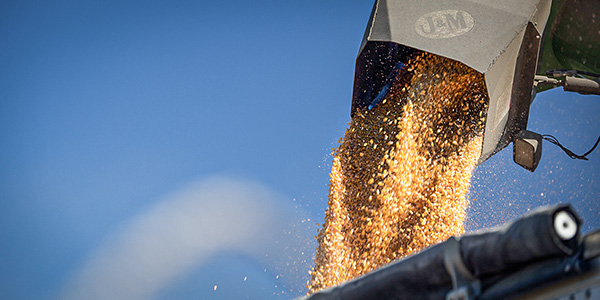AGRONOMICSUPPORT
YOU CAN TAKETO THE FIELD
Corn Harvest: Moisture and Challenges
A period of one calendar year has challenged farmers throughout the Midwest with two completely different harvest conditions. In 2019 we battled corn that would not dry down, low test weights, compaction and a long, drawn-out harvest season. In contrast, 2020 brought almost a completely opposite harvest season. Many growers were not able to harvest their corn fast enough as we had drier conditions leading into harvest. It was not uncommon to find corn below 15% and, in some cases, even in the 11-13% range. These moisture levels led to a completely different set of challenges for the harvest season such as header loss, stalk quality concerns and the potential for phantom yield loss.
Header Loss
According to Iowa State University, harvest loss is lowest when corn kernel moisture is between 19 and 23%. As we get below those moisture levels, we begin to see an increase in potential harvest loss, with most of that loss being from shelling at the combine head. The impact force of the ear with combine head is increased in dryer corn and we see kernels bounce out of the head or filter through stripper plates. Kernel losses can be measured by laying out a 10 square foot area. 2 kernels per square foot results in about one bushel per acre loss. Deck plat settings, gathering chains, cross auger positions and feeder house adjustments are all things to pay attention to help minimize header loss.
Stalk Quality
Corn hybrids are developed to produce an ear of corn, regardless of the conditions it faces. As we get into dryer environments, the corn plant will begin to cannibalize itself and produce the best ear of corn it possibly can. This can lead to stalk quality concerns as we pull nutrients from the leaves and stalk to the ear to continue filling kernels. Targeting fields and hybrids that are showing stalk quality issues and harvesting them first will help minimize any potential losses.
Phantom Yield Loss
A somewhat controversial topic, phantom yield loss is best described as a “phantom” loss of corn yield when corn is harvested at different times and different kernel moistures. Growers harvesting corn at a 23-25% kernel moisture and yielding 220 bushels per acre have sometimes noticed that if they let that corn dry and harvest at a lower moisture level of 15-19%, their yield may be 200 bushels per acre and they aren’t able to find the kernels on the ground to justify the missing bushels. Iowa State University published an article with more details if you’re interested in learning more about Phantom Yield Loss.
Future Considerations
As we deal with more kernel loss due to lower moisture, there are a few things to consider. Volunteer corn may be more aggressive in the field that suffered loss next year, so consider mixing in a herbicide to help control volunteer corn. Volunteer corn is more than just an eye sore. Besides just robbing yield, it can also be a host for corn rootworm in a soybean field, which leads to further issues when the field is rotated back into corn.
If nothing else, the previous two growing seasons have shown the importance of planting a range of maturities. 2019 was a year when the earlier relative maturity corn was needed to ensure physiological maturity, and 2020 showed that later relative maturity corn really does provide a yield advantage when we can plant early and get the necessary heat units. Continue to plant a mix of corn with varying maturities to help spread risk each year. Talk to your local LG Seeds team member with questions about how to find the right mix of corn hybrids for your farm.






Technical Team Agronomist